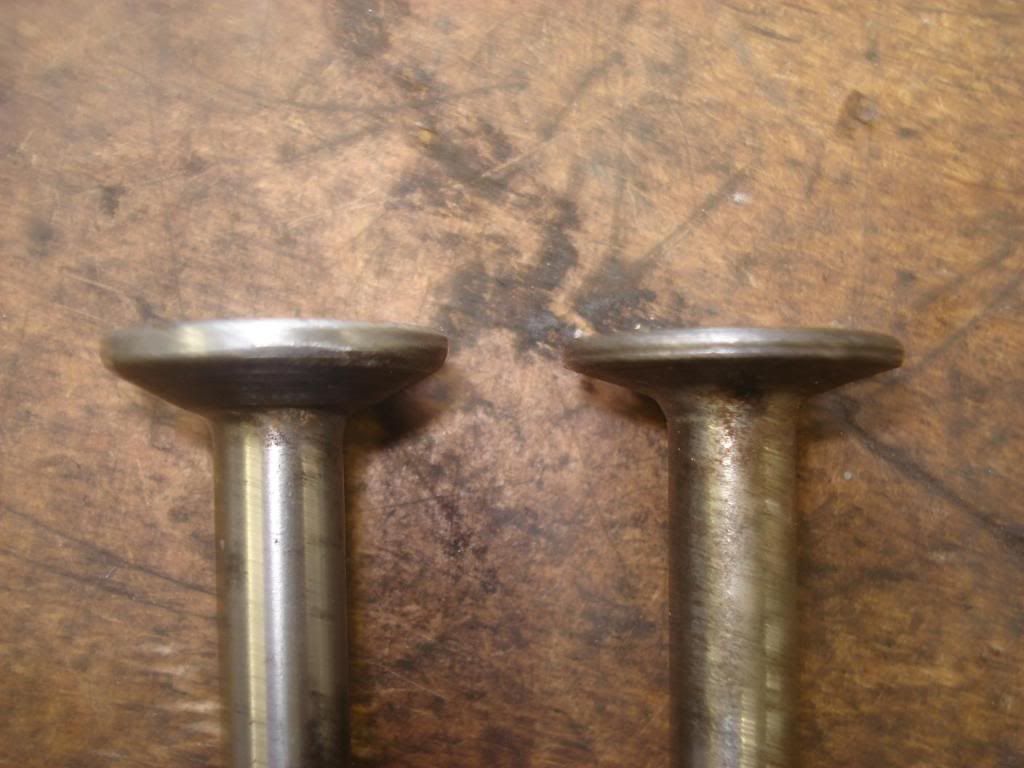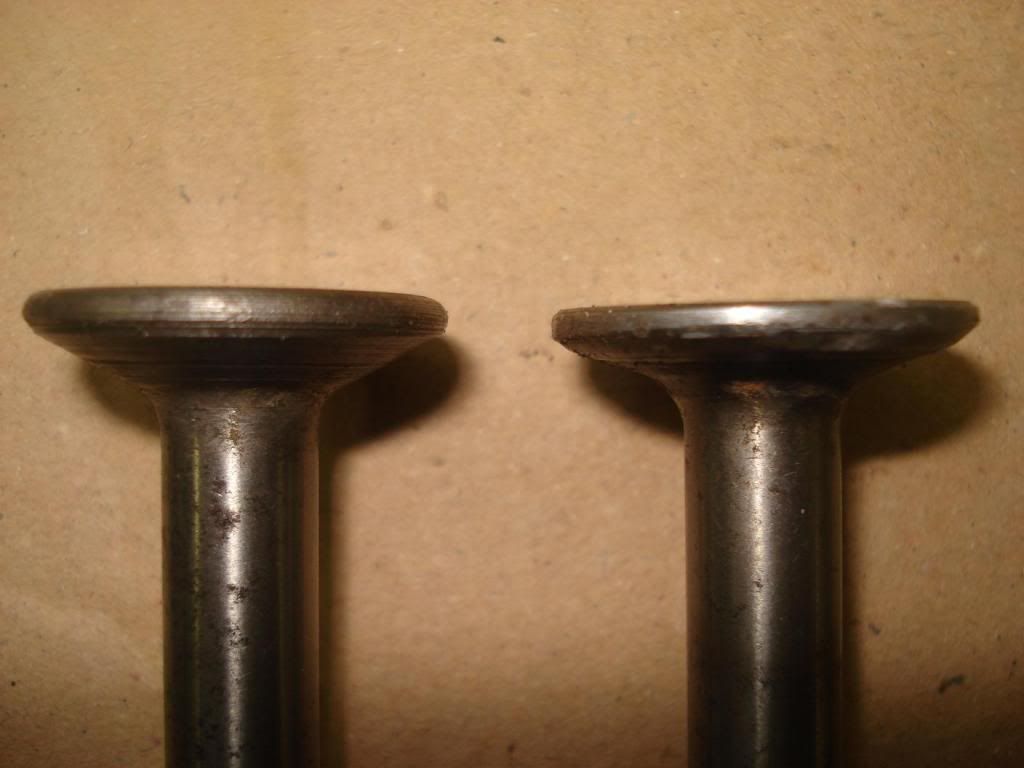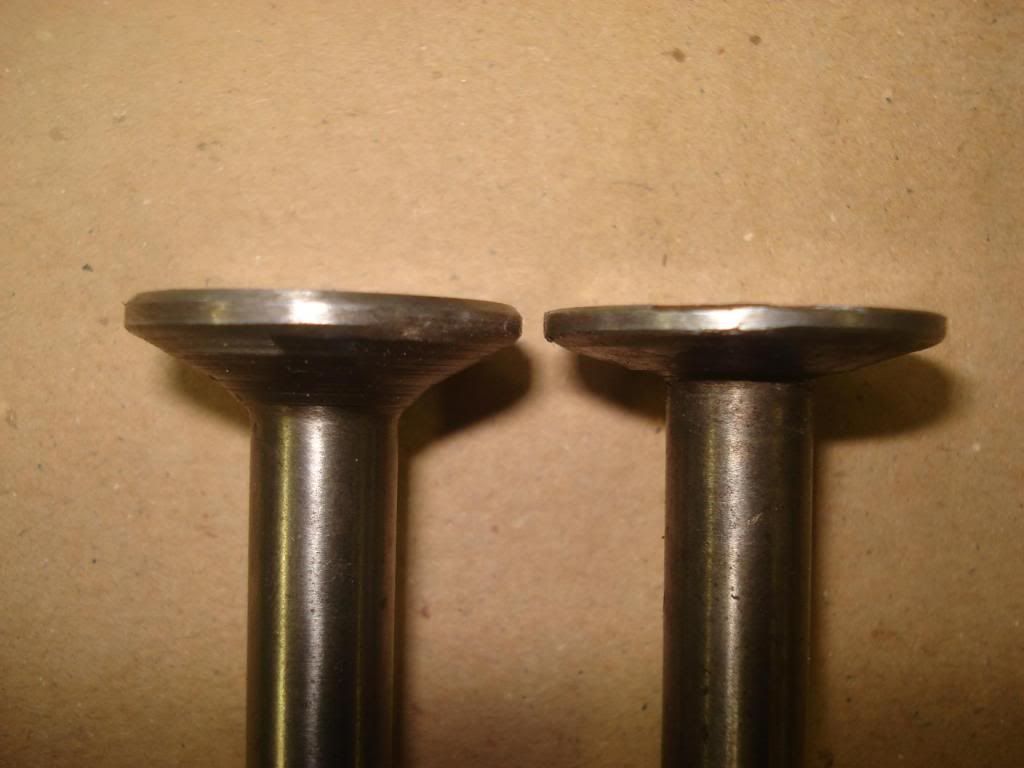Postwar (and war ??) the tappets have different partnumbers for the inlet (66-1493) and exhaust (66-1495), while in 1940 they are the same (66-1493). Also I can't find any difference between the examples I have, Can anyone clarify ?? Thanks, Michiel
email (option): m.wijbenga@hotmail.com
Hi Michiel..The only difference that I have noted is that some tappets have a thicker head than others.
The angle on the back of the tappet head comes close to the flat face on the thinner ones, leaving a very narrow 'land'..it is noticeably wider on the thicker type. Other than that I have not spotted any difference and I don't know how, or if, that difference relates to the part numbers.
It took me years to find out the differences..and more particularly the reasons for them, of the cam spindles..this one might run for a while as well...unless someone knows more.. ..And here's another question..there are three types of internals for the crankcase breather assembly..anyone know anything about those regarding periods of use etc. etc.?...Ian
..And here's another question..there are three types of internals for the crankcase breather assembly..anyone know anything about those regarding periods of use etc. etc.?...Ian
email (option): ian@wright52.plus.com
I took a look through some parts lists last night and it seems 1940 was the last year for tappets under the same part number. All later wartime and postwar models are listed with seperate numbers for inlet and exhaust.
Unfortunately my parts lists don't go back beyond 1940 but I would assume earlier models used the 'common' part.
As with the cam spindles it is difficult at first sight to come up with a reason for a different spec. as both parts work in pretty much an identical environment. They use different tappet heads...could there be a small difference in thread length at the upper end?..It seems unlikely but worth checking out..Ian

email (option): ian@wright52.plus.com
Hi Ian, Can't find any difference in the threads, but you mentioned the difference in thickness of the face: could it be that the thinner ones permit the use of a higher cam ?
With the M20 cam the tappet has plenty of space left between the face and the guide but these tappets were also used in the B-series if I am right. Also not very likely but just a suggestion. Regards, Michiel
email (option): m.wijbenga@hotmail.com
could it be that they are of different heat ratings
Hi Michiel..No, it's not cams...None of the cams of the period have enough lift to cause problems with the tappets. Also, a 1941 change date came at a time when they weren't producing any 'sporty' models anyway. I have had cams made with sufficient lift to cause a problem and have shortened the inlet tappet guide to solve the problem..a solution that would have been used by BSA themselves I would imagine had a problem occurred.
I don't think heat would be an issue particularly either (leading to different treatments). If there was sufficient and high enough heat transfer from the exhaust valve to affect the tappet I would have thought the valve and tappet head would have been having real problems at that point....Ian
email (option): ian@wright52.plus.com
Hi Ian, your right, 1941 was no time for high cams...
They are probably the same as when they really are different why not make them look different so they are not mixed up during assembly.
Thanks for your thoughts, Michiel
email (option): m.wijbenga@hotmail.com
Just read in Roy Bacon's Singles Restoration : " The tappets were not the same, as the exhaust one was given a special treatment by the factory"... ... Michiel
... Michiel
email (option): m.wijbenga@hotmail.com
Well, if that is correct...why was it done and how can the different parts be identified once removed from an engine?..'Special treatment' would be a different level of heat treatment I would think but it is not obvious what is different about the operating conditions of the exhaust tappet to require that. The cams are identical as are the valve spring pressures and both tappets are 'splash' lubricated by oil vapour in the timing chest. The only difference I can see is that the exhaust tappet might be exposed to a higher temperature than the inlet one but I am not convinced that would be sufficient to make any difference, or that different levels of heat treatment would solve a problem of substantially higher operating temperatures. In the case of the exhaust valve for instance that problem is addressed by the use of a different material. An increase in surface hardness or a process such as 'Tufriding' would enhance wear resistance and that implies a higher load...but I can't see how that would occurr. Alternatively, perhaps there is a marginal difference in the amount of lubrication to the two tappets?.The problem with that idea though is that it would apply equally to the cam surface and they are not treated differently..Despite my reservations it does seem operating temperature might be the issue..but that remains to be confirmed, as does the specific treatment used ...Roy Bacons information only provides half the answer unfortunately ...Ian
...Ian
email (option): ian@wright52.plus.com
i ca'nt remember what with but a wolseley 6/80 of which i had one a worseley car that is not just an exhaust valve an exhaust valve was coated with something and once used the coating was burnt away to some extent so marking then was'nt necessary and would need to be replaced not to be lapped in
Mr Bacon also states that the B range used the M20 inlet tappet for both tappets, so the close presence of the hot exhaust valve indeed looks to be the reason. But what the difference is is sadly not stated.
I have checked a few crankcases and it is usually the exhaust tappet face which is worn hollow while the face of the inlet tappet is not worn at all.
But also looked closer to the flat surface of the tappets and found a damaged one which looks like some layer is chipped from it, and that on exactly half of my tappets the circumference of the flats is (hand)grinded, so it looks like the difference is the surface of the flats (hardchrome ??)


Left is grinded, Regards, Michiel
email (option): m.wijbenga@hotmail.com
Hi Michiel..What a great hobby this is..However long you mess about with these things there is always more to learn.
Firstly, I am interested in the outside diameter of the head of the two types of tappets..If the exhaust ones have been ground on the O.D. they may be smaller.
This might explain the impression I had that some were thicker than others when in fact it would only be a case of the 'land' being made wider as the O.D reduces into the tapered section.
This would also make for an easy way of identifying the two types.
It certainly does appear that the example you pictured has a hard chrome surface..or possibly a shallow depth 'case hardened' layer..which has broken away.
The fact that this treatment was only applied to the sidevalve exhaust tappet leaves exposure to heat as the only viable theory I can think of to warrant this treatment at the moment..
As yet I have found no reference in BSA or WD literature regarding the importance of fitting (or refitting) the tappets in their correct locations..and that is puzzling..
Presumably the sliding motion of the stem of the tappet in its guide and the operation of the tappet head under the valve stem are sufficiently different in nature to the heavy 'scuffing' loads on the tappet head not to require similar treatment.
In the absence of any further information I think the effects of additional heating must be regarded as the reason for the modification...which frankly I still find surprising.
All very interesting stuff and my compliments on your careful observations....Ian
email (option): ian@wright52.plus.com
Hi Ian, it sure is a wonderful hobby, as it is discussing about it, it makes you dig in deeper...
I have measured a few tappet heads and there is a variation in diameter but no specific difference in inlet or exhaust. The grinding also seems to be done by hand, possibly a burr from the chroming process that has to be removed?
The easiest way of identifying the two types seems to be the grinding imprints from the exhaust compared to the circular 'ridges/traces' from the production process. Here another picture:

Also the surface of the exhaustface is a bit brighter.
When you have them in hand and know where to look at, you can easily identify them, but there are some doubtcases between them..
The thickness of the head seems to make no difference as these picture are both exhaust tappets: you can clearly see the variation in the amount of material and the grinding.

Regards, Michiel
email (option): m.wijbenga@hotmail.com
Hi Michiel, OK, so identification is by the different colour of the hard plated finish and the hand fettling marks around the edges where the 'flash' from the plating process was removed.
I notice in the last photo that the the 'thicker' tappet on the left has both a different angle and a larger radius on the back of the head where the head blends into the stem. This would make for a stronger tappet.
Is this a consistent difference on the 'thick' and 'thin' ones?...You have noted that the thicker head is not particular to either tappet...but I wonder if the thicker type is a later, improved type..particularly as the angle appears to have been altered....Ian 
email (option): ian@wright52.plus.com
Hi Ian, I checked a few but can't find two exactly the same, radius, angle, thickness they all vary.
Also checked a few tappets which are still in my early cases and they are all of the 'thicker' type. This makes me think the thin ones are of later date.
On the thin headed ones the grinding of the stem is continued close to the head as the radius which blends into the stem is in some cases formed by the grinding stone, So these tappets can accept a far higher lift than the thicker ones.
You said you had to shorten a guide to accept a higher cam, but could it be that the factory choose to make the tappetheads thinner instead of shortening the guides so that the guides are as close to the cams as possible, (for the B-series of course)?? we discussed this already but it keeps coming in my mind, and I don't have higher cams to check...... Regards, Michiel
email (option): m.wijbenga@hotmail.com
Hi Michiel..I have fitted post war Gold Star Scrambles cams to numerous engines and have never 'selected' the tappets I fitted. The only cam with greater lift is the Clubmans inlet cam.
I had to shorten the tappet guide in my M20 sprinter project as I had a cam manufactured to my own spec with more lift and duration than any existing BSA cam.
It is possible that, by chance, I have always fitted the correct tappets..or clearance may not be an issue with either type. I have a number of sets of crankcases with tappets fitted and various cams so I will take a look and test the theory. I'll let you know the results...Ian
email (option): ian@wright52.plus.com
Could it be a wartime change in material due to shortages of nickel or something similar that meant they had to use a different case hardening process? Or possibly a result of failures reported back to BSA by the military due to harder/longer usage ie larger miles covered by convoys than most of the pre war public would have done on a regualar basis? Just a thought!
email (option): davmax@ntlworld.com
Hi Dave..Either of those suggestions could be a possibility I would have thought. Running for extended periods at very slow speeds on convoys and frequently in extreme environments like North Africa might well have led to problems not previously experienced...Ian
email (option): ian@wright52.plus.com
It does seem a little odd that the change happened at probably the time of most shortages in the UK, also there would be a larger feedback from hard users of WD bikes as the failure forms that the WD had would be handed to the manufacturer especially if it was a common failure. I think Matchless changed the pistons as a lot of them suffered seizures, this was reported to Matchless and as a consequence they changed the pistons
email (option): davmax@ntlworld.com
Hi Dave..This modification only applied to the exhaust tappet..and only in sidevalve engines.
For that reason I tend towards an unexpected mechanical problem rather than the idea of material/process shortages, which would have had the same effect across all engine types and both tappets, when the same tappet was universally used.
OHV engines always used the same tappet for inlet and exhaust..even into the post war period. The sidevalve also had common parts prior to the introduction of this modification...Ian
email (option): ian@wright52.plus.com
So, here is a pair of NOS followers, and pictures of WM20 and M20 bottom ends with followers in place...original fitment as far as I can tell.
From what I have gathered from the previous discussion, the follower with the thicker face and greater angle is in fact different, (not just variations in mfg) and "correct" for the exhaust...



email (option): teladelujo@msn.com
That's right John..it appears BSA hard chrome plated the face of the exhaust tappet because of the exposure to transfered heat in that type of engine. OHV models retained identical tappets...Ian
email (option): ian@wright52.plus.com
